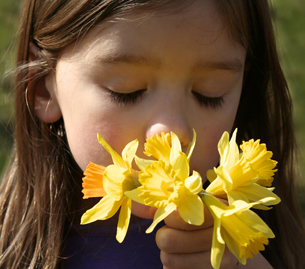Module 1
1. Module 1
1.22. Page 4
Module 1—The Nervous System
Smell
 Read
Read

© Terrie L. Zeller/shutterstock
How does scent or fragrance affect you? For example, what happens when you catch the scent of a fragrance as you approach somebody? That smell may make you want to get closer, but it may have the opposite effect on the friend you are with. In fact, he is sneezing and his nose and eyes are running. Are your senses communicating perceptions that are different than those of your friend? To learn more about smell and what it communicates, read “Smell” on page 426 in your textbook.
Smell, much like taste, detects chemicals in solution. Olfactory receptor cells are stimulated by chemicals only when in solution. A sensory nerve communicates this information to the frontal and temporal lobes of the brain. Cells in the olfactory epithelium produce a continuous secretion of mucous in which molecules of airborne chemicals dissolve. Mucous is continuously secreted to flush away old odour chemicals so that new odour chemicals may gain access to the receptors. Smells associated with dangers, such as smoke, natural gas, or skunk, trigger the sympathetic nervous system. The perception of unpleasant odours can trigger sneezing or a gag reflex. Because your perceptions are based on your unique experiences, your perceptions can be very different from your friend’s perceptions.
olfactory (receptor) cell: a neuron located in the olfactory epithelium that is specialized to receive chemical stimuli and to initiate a nerve impulse
olfactory epithelium: a patch of tissue located in the upper part of the nasal cavity that contains mucous-secreting cells and olfactory cells, or smell cells, that can detect different smells; a sense organ for smell
 Self-Check
Self-Check
SC 6. Provide names for structures 1 to 14.

Inquiry into Biology (Whitby, ON: McGraw-Hill Ryerson, 2007), 427, fig. 12.26. Reproduced by permission.
SC 7. What has to happen to airborne chemicals, like those of a rose, before they can be smelled?
SC 8. What is the function of structure 10?
SC 9. What is the purpose of the olfactory cilia on the olfactory cell (receptor cell)?
SC 10. Where is the nerve impulse initiated?
SC 11. Outline the specific sensory pathway involved in smelling a rose.
 Self-Check Answers
Self-Check Answers
SC 6.
Structure 1: frontal lobe of cerebrum
Structure 2: olfactory bulb on underside of cerebrum
Structure 3: olfactory epithelium
Structure 4: airborne chemicals from rose
Structure 5: nasal cavity
Structure 6: olfactory bulb enlarged
Structure 7: sensory neuron
Structure 8: bone
Structure 9: sensory fibres
Structure 10: olfactory gland
Structure 11: olfactory (smell) cell
Structure 12: cilia (hairs) on olfactory cell
Structure 13: odour molecules dissolved in mucous
Structure 14: olfactory epithelium
SC 7. Airborne chemicals have to be dissolved before they can fit into receptors on olfactory cells.
SC 8. The olfactory glands (structure 10) continually produce mucous to dissolve airborne chemicals and to wash away old odours.
SC 9. The cilia (hairs) increase the surface area so that more odour molecules may reach more receptors.
SC 10. The nerve impulse is initiated at the cilia on the olfactory cell and transmitted to the neurons in the olfactory bulb.
SC 11. The main steps of smell perception include the following:
- Odour molecules are breathed into the nasal cavity.
- Odour molecules dissolve in mucous produced by olfactory glands of the nasal epithelium.
- The molecules in solution attach to receptors on the cilia (hairs) of olfactory cells.
- The sensory receptors or olfactory cells (specialized neurons) initiate nerve impulses that are sent via the sensory neuron to the olfactory bulb and then to the temporal lobe of the cerebrum where it is interpreted as a scent.